Most of the world believes that ALL of the animals in Australia are capable, and in some cases – actively trying(!) to kill you (Dropbears, I’m looking at you..) But while it is true that Australia has quite a few animals that can kill you, the majority of our Australian animals are more of the cute and cuddly kind – or at the very least weird, wacky or interesting, rather than deadly.
And to help you identify over 30 of the most famous Aussie animals, we have put together this complete Australian animals guide which features pictures, facts, where to find them AND if in fact, they are actually dangerous!
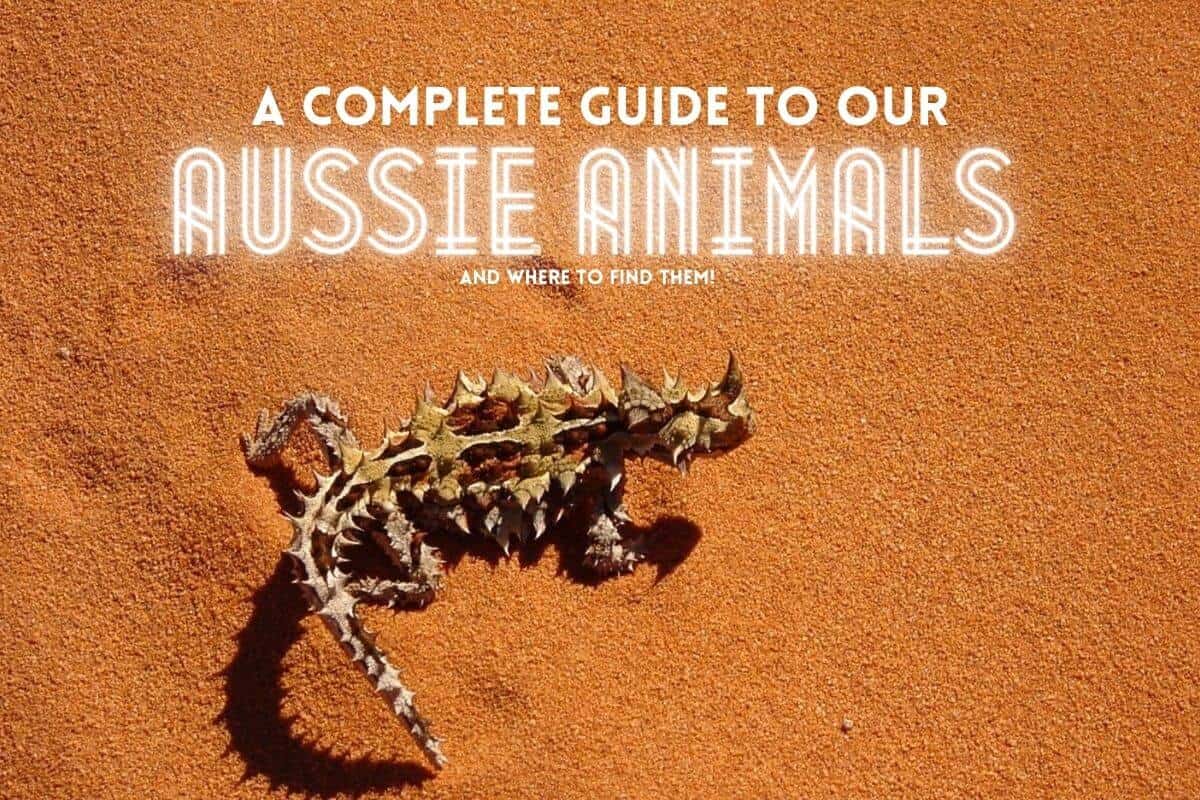
Table of Contents
- 1 Native Australian Animals
- 1.1 Kangaroo
- 1.2 Koala
- 1.3 Saltwater Crocodile
- 1.4 Quokka
- 1.5 Echidna
- 1.6 Wallaby
- 1.7 Wombat
- 1.8 Numbat
- 1.9 Camel
- 1.10 Bandicoot
- 1.11 (Duck-Billed) Platypus
- 1.12 Fruit Bat
- 1.13 Thorny Devil
- 1.14 Cane Toad
- 1.15 Sand Goanna
- 1.16 Dingo
- 1.17 Tasmanian Devil
- 1.18 Bushy Tailed & Ring Tailed Possum
- 1.19 Quoll
- 1.20 Christmas Island Red Crab
- 1.21 Robber Crab / Coconut Crab
- 1.22 Australian Coastal Taipan
- 1.23 Huntsman Spider
- 2 Native Australian Birds
- 3 Australia’s Famous Sea-Life
Native Australian Animals
Kangaroo

Scientific Name: The four species of kangaroo are: the red kangaroo (Macropus Rufus), the eastern grey kangaroo (Macropus giganteus), the western grey kangaroo (Macropus fuliginosus), and the antilopine kangaroo (Macropus antilopinus).
Lifespan: Average of 6 years in the wild (upwards of 20 in captivity)
Where in Australia are Kangaroos Found? Throughout the country, but with a preference for woods and bushland, as well as grassland, savannas, forests and scrubland.
Collective Noun: Mob of Kangaroos
The most famous of Australia’s indigenous animals and a symbol of Australia for many, kangaroos are so populous in Australia it is believed they actually outnumber humans (!)
Fully grown male red kangaroos can grow up to 6ft tall and would be quite intimidating should you come across one (do you remember Roger?!) – but they are not typically aggressive with humans. While comics and cartoons depict them as ‘boxers’ – this is how male kangaroos show dominance with other male kangaroos and to prevent intruder males from breeding with the females in their ‘mob’.
Where kangaroos do pose a danger to humans is when it comes to driving in the outback at night. That’s where 80% of collisions involve kangaroos – and who can cause major damage if they connect with the side of your car. For this reason, most rental car companies will not cover kangaroo related incidents when driving in the bush.
Quick Facts about Kangaroos
- Kangaroos can travel up to 60km/h, jump up to 1.8m high and cover as many as 9m in a single bound
- Kangaroos are the largest living marsupials in Australia, but they are tiny when born, usually around the size of a jelly bean.
- Kangaroos are marsupials who carry their babies (called Joeys) in their pouch
- A Male Kangaroo is called a Boomer, a female, a Jill.
- Kangaroos are strict Herbivores, and quite happily exist on a diet of grass and scrubland.
- Kangaroos have incredible hearing and can swivel their ears to pick up sounds.
Koala

Scientific Name: Phascolarctos cinereus
Lifespan: 13-18 years
Where in Australia are Koalas Found? Koalas generally live in the eucalyptus forests of southeastern and eastern Australia as they rely on the eucalyptus tree for both habitat and food.
Collective Noun: There is no collective noun as they are typically solitary creatures
Koalas are well-known for their large round head, big furry ears, and a black nose. Their fur is usually grey-brown in colour with white fur on their chest, inner arms, ears, and rear. They have no fur on their nose or the palms of their paws. Koalas have hard bottoms, which allow them to wedge comfortably in tree forks for long periods of time.
Koalas have poor vision and rely heavily on their other senses – more so on their sense of hearing – to detect predators and other koalas around. Their acute sense of smell also helps them detect other koalas nearby and their favourite food trees.
In fact, male koalas rub their chest up and down a tree trunk to mark trees and attract females. Their scent gland on their chest which oozes a clear, oily, strong musky smelling liquid to mark trees and attract females.
Quick Facts about Koalas:
- Koalas can eat more than 450g (1 pound) of eucalyptus leaves a day.
- Koalas sleep so much (18-22 hours per day) because they get very little energy from their diet. As eucalyptus is toxic, the koala’s digestive system has to work hard to digest it – breaking down the toxins and extracting limited nutrients.
- Although they look fuzzy, a koala’s hair is more like the coarse wool of a sheep.
- Koalas have two opposing thumbs on their hands, and both their feet and hands have rough pads and claws to easily grab onto branches.
- Koalas also have two toes fudged together on their feet which they use to groom themselves.
Saltwater Crocodile

Scientific Name: Crocodylus porosus
Lifespan: 70 years
Where in Australia are Saltwater Crocodiles Found? Saltwater crocodiles live in the Northern part of Australia in a warm and tropical climate. You can find them along the north coast between Broome (WA) and Rockhampton (QLD), and up to 200km inland.
Collective Noun: Bask
The Saltwater Crocodile is the world’s largest living reptile species, growing up to 6m long and weighing up to a ton! Saltwater crocs (a.k.a. Salties) are also perfectly evolved predators. Saltwater crocodiles can live in coastal habitats, but they are very much comfortable in freshwater rivers as well. These reptiles are so well adapted to life in saltwater that they can spend days or even weeks at sea — drifting and swimming hundreds of kilometres.
They usually lie in wait partially submerged or completely underwater when hunting. They can hold their breath for up to an hour by reducing their heart rate to just 2-3 beats per minute! They have special transparent eyelids that enable them to see underwater. Salties are also experts at judging the distance of their prey because of their eyes’ forward-orientation.
Quick Facts about Saltwater Crocodiles
- The saltwater crocodile is the largest reptile on the planet with a length of more than 23 feet (6.5 m) and weight of over 2,200 pounds!
- A Saltwater Crocodile’s powerful jaw is filled with 64-68 teeth — the greatest bite pressure measured in any living animal.
- The saltwater crocodile is responsible for at least several dozen attacks on people each year.
- Saltwater crocodiles are fast swimmers and great hunters underwater, but they cannot swallow their prey under the water.
Quokka
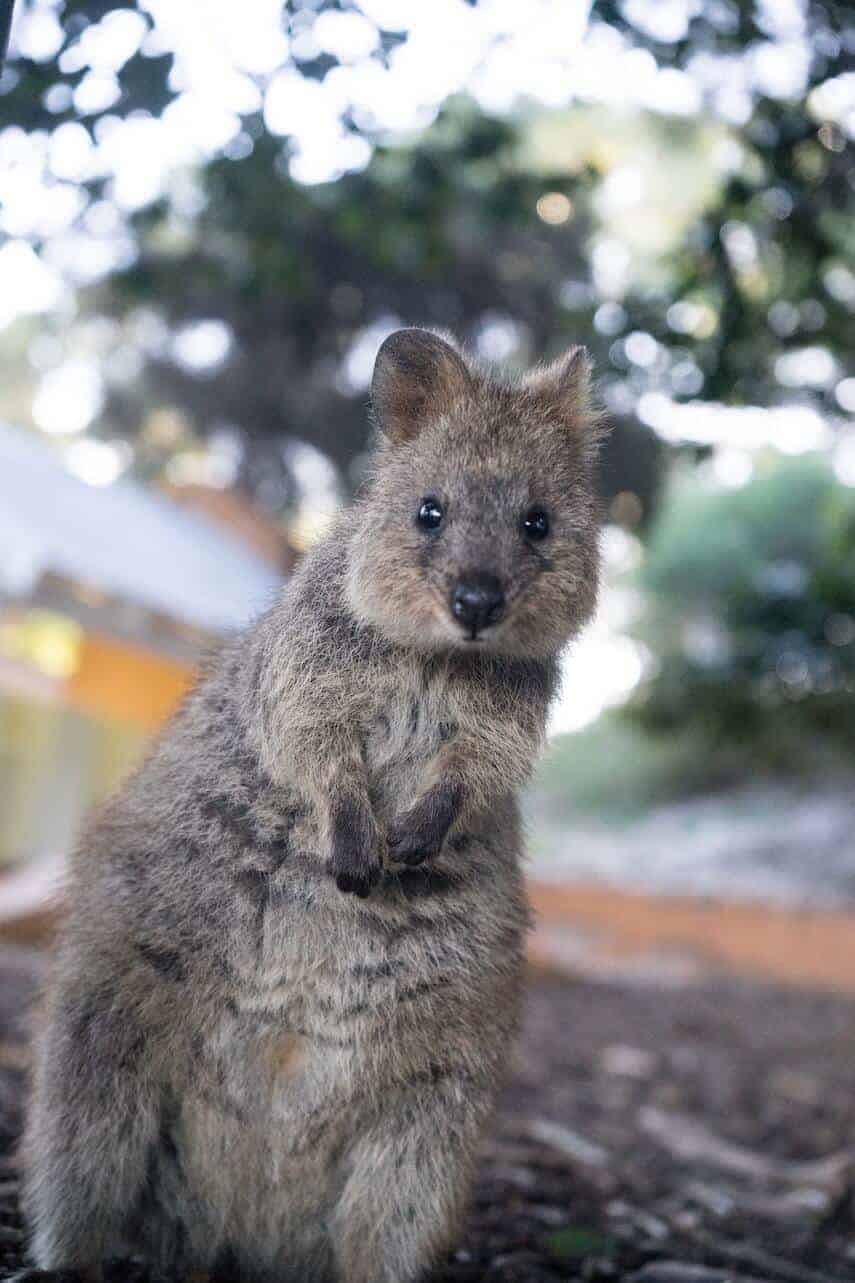
Scientific Name: Setonix brachyurus
Lifespan: 10 years
Where in Australia are Quokkas Found? Restricted to the southwest region of Western Australia, quokkas are found on the mainland as well as on Rottnest Island (near Perth) and Bald Island (near Albany).
Collective Noun: Shaka (thanks to Kelly Slater!)
Quokkas are small, four-legged animals covered in fur. They’re from the kangaroo family and also have pouches in their abdomens for carrying their young. Though they’re much tinier than kangaroos, the quokka is around the size of a domestic housecat.
Quokkas generally have narrow faces, round ears, big noses, tiny paws, and short and skinny tails. Their most distinctive feature is their smile. Known as the most cheerful animal in the world, quokkas have a perpetually happy expression on their face which ranges from a tiny smile to a toothy grin!
Quick Facts about Quokkas
- Rottnest Island is only about seven miles around — and more than 10,000 quokkas call it home.
- Quokkas have little fear of human contact which is why they’ll hop right up to people who are marvelling at them.
- Quokkas were given the “happiest animal on earth” title by The Huffington Post in a report that went viral back in 2013.
- There are times when fresh water is so scarce that the quokka can only stay hydrated through the nutrients of plants.
- Quokkas can have a bit of a mean streak to them. They aren’t afraid to bite when they’re feeling threatened, and they also have powerful hind legs they use for kicking (and hopping).
Echidna
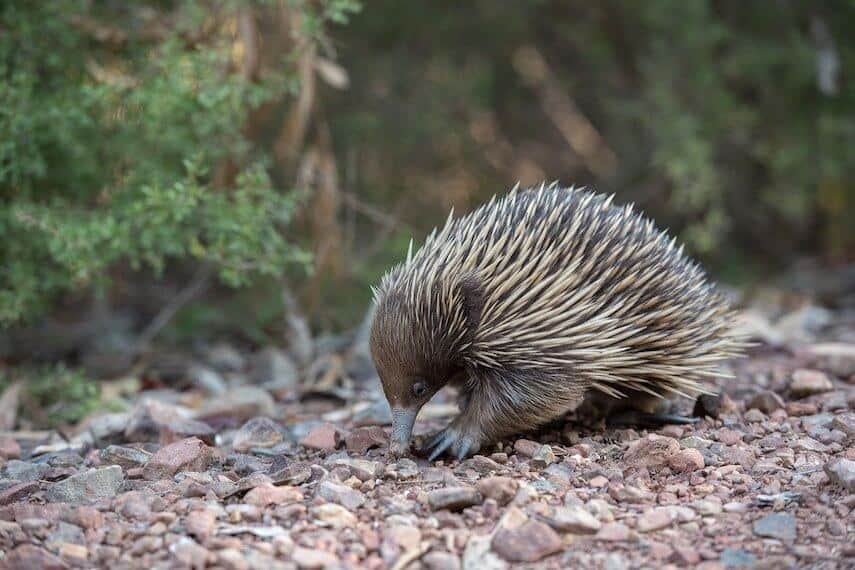
Scientific Name: Tachyglossidae
Lifespan: Around 10 years
Where in Australia are Echidna Found? Echidnas are found across most of Australia and hold the title of Australia’s most widespread native mammal around most habitats, from deserts to rainforests, and alpine mountains.
Collective Noun: Flock, herd, parade
Echidnas are monotremes (along with the Platypus) which means they are the only mammals in the world that lay eggs. Their snouts are rigid and strong, allowing them to break logs and termite mounds. Echidnas then slurp up ants and other insects with their sticky, saliva-covered tongue that is around 17cm long!
Echidnas have a very keen sense of smell that they use in locating mates, detecting danger, and snuffling for food. Their short limbs and shovel-like claws are perfect for digging out food and burrowing in the soil. They use their hard, sharp spines for protection. Beneath these 5cm-long spines, echidnas are covered in short black hair which helps them to live in a wide variety of habitats.
Quick Facts about Echidna:
- Echidnas vary in colour depending on their location. In the northern and hotter regions echidnas are light brown, they become darker with thicker hair in the southern regions, and those in Tasmania are black.
- Echidnas typically live up to 10 years in the wild but have been recorded living 49 years in captivity!
- Although they look fearsome enough, echidnas are shy animals and would rather retreat than fight if disturbed.
- An echidna will curl into a ball when threatened, lodge itself into a log or rock crevice, or quickly dig a shallow excavation so that only its sharp spines are exposed.
Wallaby
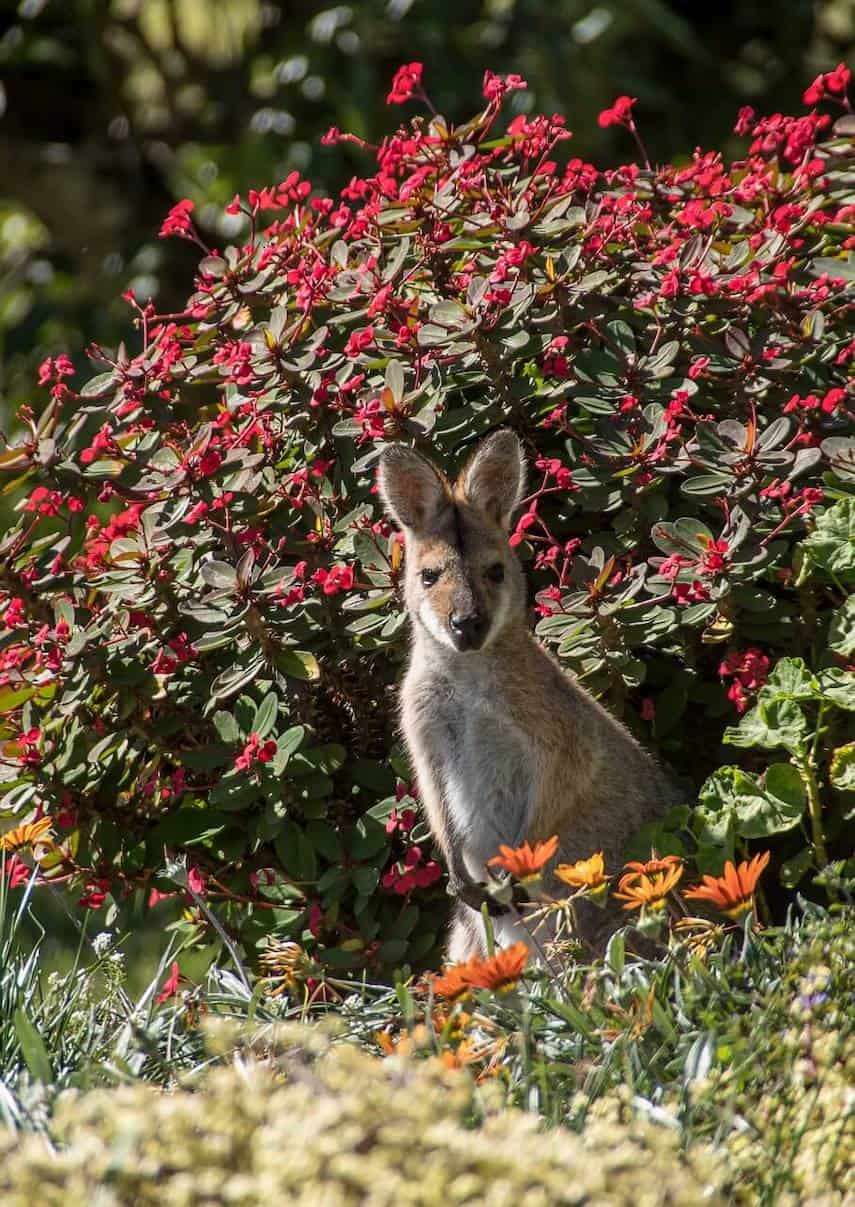
Scientific Name: Macropodidae
Lifespan: Around 9 years.
Where in Australia are Wallabies Found? Wallabies are found in the following locations:
- Bridled Nail-tail Wallaby: Goonderoo (Qld).
- Yellow-footed Rock Wallaby: Boolcoomatta (South Australia).
- Tammar Wallaby: Beringia, Cherininup, and Chingarrup (WA).
- Black-gloved Wallaby: Beringia, Cherininup, Chingarrup, and Kojonup (WA).
- Monjon: Wunambal Gaambera (WA).
- Swamp (Black) Wallaby: Yourka (Qld), Brogo, Burrin Burrin, Scottsdale, and Tarcutta (NSW), and JC Griffin and Nardoo Hills (Vic).
Collective Noun: Mob, Court, Troup.
Wallabies are widely distributed across Australia — particularly in more remote, heavily timbered, or rugged areas, less so on the great semi-arid plains that are better suited to the larger, leaner, and more fleet-footed kangaroos.
Rock wallabies live almost exclusively in rugged terrain, along rocky hills, boulders, sandstone outcrops and caves. Other species prefer arid grassy plains, dense coastal health, open forests or rainforests. If you’re from southern Australia, you may be familiar with the relatively common Agile Wallaby or the Red-necked Wallaby. Some other species are increasingly hard to come across.
Quick Facts about Wallabies:
- Wallabies are more active in the evening and early morning, especially those in arid areas.
- The natural habitat of the wallaby varies by groups, such as the brush, rock, swamp, forest and shrub wallabies.
- Wallabies are often seen swimming at dusk. On land, they can only move their hind feet together but when swimming they can kick each leg independently.
- Female wallabies have the remarkable capacity to successfully produce two different kinds of milk at once: one suited to the developing joey and the other for the larger joey that has already left the pouch.
Wombat
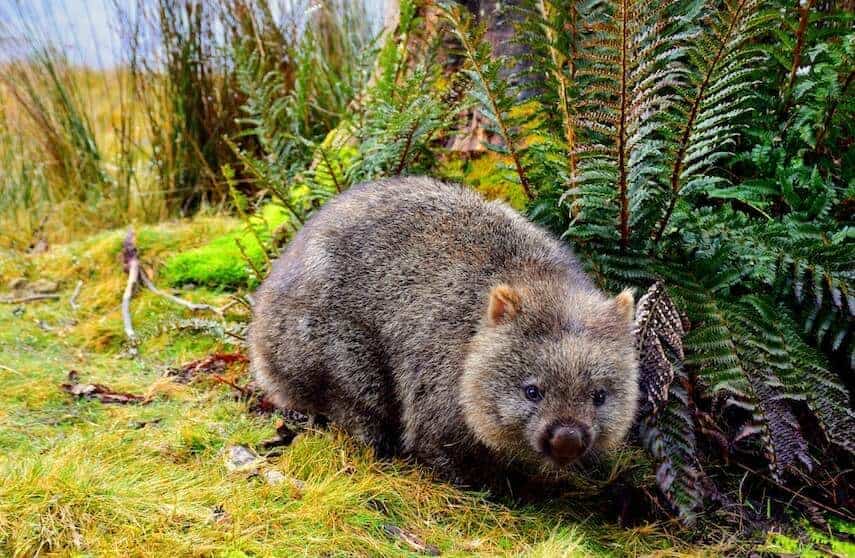
Scientific Name: Vombatidae
Lifespan: 15 years
Where in Australia are Wombats Found? They were once widespread throughout southern Australia. Currently, they are found in parts of eastern NSW, Victoria, south-eastern South Australia, and Tasmania.
Collective Noun: Wisdom, Mob, Colony.
The wombat is a nocturnal animal and the world’s largest burrowing herbivorous mammal. The three wombat species found in Australia are respectively the common wombat and both the southern and the northern hairy-nosed wombats.
Wombats use their strong claws to dig burrows in open grasslands and eucalyptus forests. They live in these burrows, which can become extensive tunnel-and-chamber complexes.
Quick Facts about Wombats:
- One of the more unusual facts about wombats is that they have cube-shaped poop.
- A wombat’s rear end is their main form of defence against predators. When a predator is near, they dive down their burrows and block off the entrance with their butts that are very resistant to scratches and bites.
- Their teeth never stop growing which is perfect when they are munching on grasses, roots, shrubs, and vegetables.
Numbat
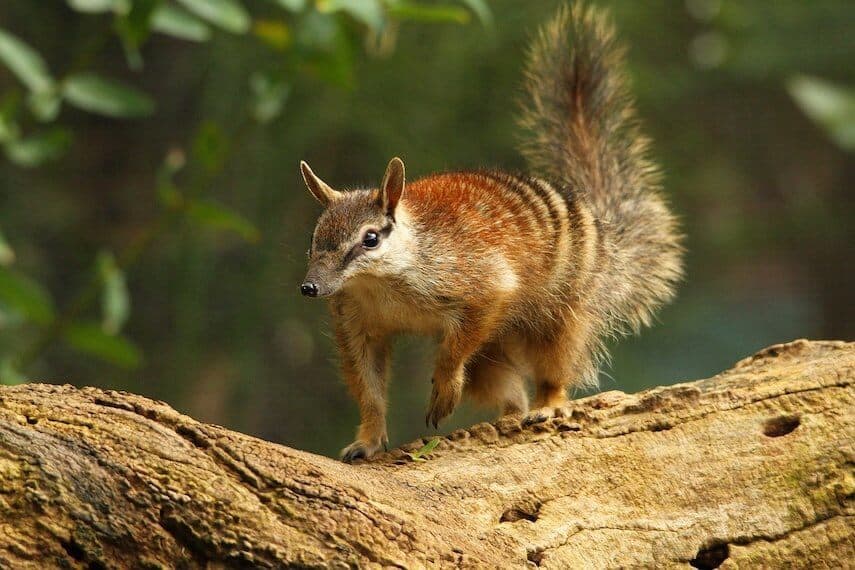
Lifespan: Approx 5 years
Where in Australia are Numbats Found? Two natural populations remain in the southwest of Western Australia. One at Dryandra Woodlands (near Narrogin) and the other at Perup Nature Reserve (near Manjimup).
Collective Noun: Like Koalas, they are solitary animals and as such have no collective noun.
The Numbat, also called the banded anteater, is a small endangered marsupial animal native to parts of Australia. The Numbat has a long, slender sticky tongue (approx. 10-11 cm long) that it uses to dip into narrow cavities in logs, leaf litter and in small holes in the ground to collect termites.
The Numbat also has a long pointed nose that is useful for getting into small holes in the ground and logs to search for termites. Numbats sense the presence of termites via smell and possibly small vibrations in the ground. They dig small holes in the ground to uncover the passageways (called “galleries”) that the termites travel in when they go to and from the nest.
Quick Facts about Numbats:
- Numbats do not have proper teeth like other mammals. They have blunt “pegs” because they do not chew their food.
- Numbats live in Eucalypt woodlands where old and fallen trees provide hollow logs for shelter, nest sites and foraging opportunities.
- They are strictly diurnal, which means they are only active during the day and their activity levels are closely linked to those of termites.
- They do not need access to water because they get this from the termites they eat.
Camel
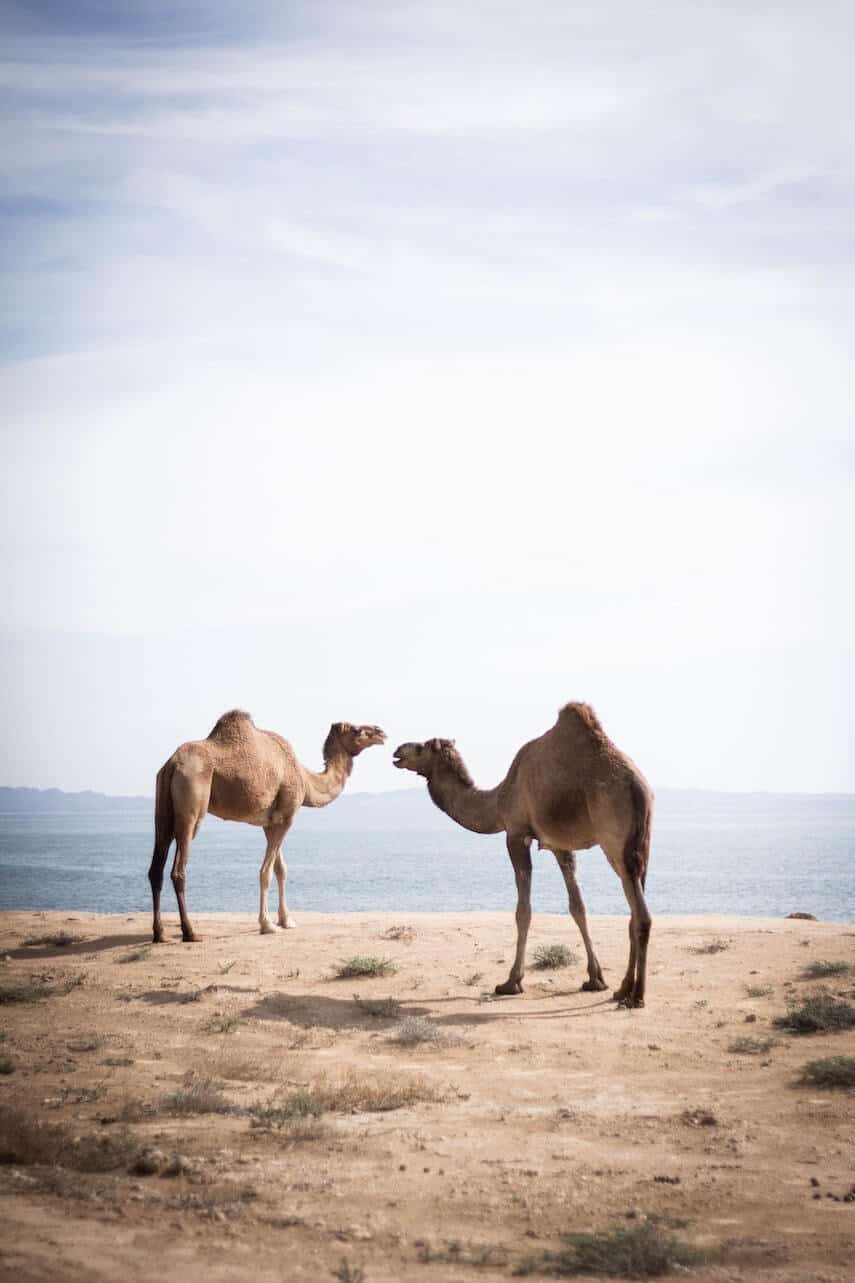
Scientific Name: Camelus dromedarius
Lifespan: 40 years
Where in Australia are Camels Found? Camels roam freely across an area of 3.3 million sq km (1.3 million sq miles) encompassing the states of Western Australia, South Australia and Queensland, as well as the Northern Territory.
Collective Noun: Caravan, Flock, Herd
Australia has about a million wild camels, one of the largest national herds of dromedaries in the world. Camels have an unmistakable silhouette, with their humped back, short tail, long slim legs, and a long neck that dips downward and rises to a small narrow head.
Their upper lip is split into two sections that can move independently. A camel’s hump consists of stored fat which they can metabolize when food and water are scarce.
Quick Facts about Camels:
- There are two types of camels: dromedary camels, which have one hump, and Bactrian camels, which have two humps.
- Camels aren’t native to Australia — they were brought over by British settlers from India, Afghanistan, and the Middle East in the 19th century.
- Camels do not walk on their hoofs. Their weight lies on two large toes that are spread apart to keep them from sinking into the sand.
- A camel can survive for about 4-7 days without drinking in severe heat. But if a camel’s forage contains enough moisture, it can live for up to 10 months without water!
Bandicoot
Scientific Name: Peramelemorphia
Lifespan: 2-4 Years
Where in Australia are Bandicoots Found? Bandicoots are found throughout Australia and can be common in coastal areas of NSW. They can live in a wide variety of habitats ranging from rainforests to wet and dry woodlands to heath.
Collective Noun: Like Koalas and Numbats, these are solitary creatures with no collective noun.
Bandicoots are small, omnivorous marsupials who are very opportunistic omnivores, eating both plants (fungi, grass seeds, berries, and fruits) and animals (insects, larvae, lizards, mice, and snails).
They are highly active and have a running style described as a “gallop”. They forage at night using their sensitive noses to smell out their food, and they also use their long, curved toes to dig out the underground fare.
Quick Facts about Bandicoots:
- There are about 7 species of bandicoots surviving in Australia.
- Bandicoots sleep in camouflaged nests made up of shallow holes lined with grass, leaf litter, and other debris.
- They waterproof their hideouts and with a layer of soil finish over the top of the nest while it’s raining.
- The interaction between males and females are restricted only to the mating season — a.k.a. the only time that females can tolerate a male’s company!
(Duck-Billed) Platypus

Lifespan: 10-11 in the Wild; up to 17 in captivity
Where in Australia are Platypus Found? Platypuses are found in freshwater creeks and rivers of Queensland, New South Wales, Victoria, Tasmania, and South Australia.
Collective Noun: Paddle
A platypus is a remarkable mammal that is best described as a hodgepodge of more familiar species — the duck (bill and webbed feet), beaver (tail), and otter (body and fur). It is also an egg-laying aquatic creature native to Australia alone.
Platypuses hunt underwater where they swim gracefully by paddling with their front webbed feet and steering with their hind feet and beaver-like tail. Their eyes and ears are covered with folds of skin to prevent water from entering, and their nostrils close with a watertight seal.
Quick Facts about Platypus:
- Newly-hatched platypuses are the size of lima beans!
- When on land, their webbed feet retract to reveal claws that help them walk.
- The platypus is one of the two types of egg-laying mammals in the world (the other is echidnas).
- The platypus is one of the three mammals that produce venom in the world (the others are the slow loris and European mole).
Fruit Bat
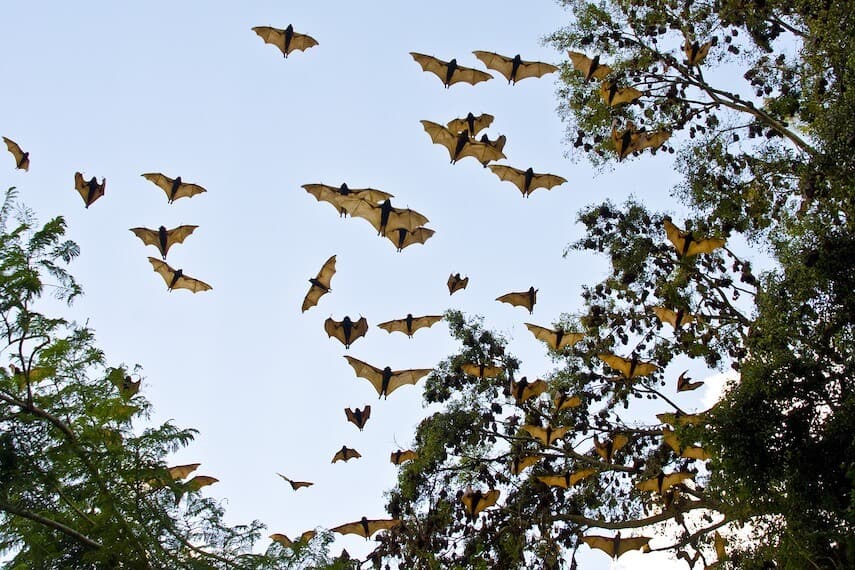
Scientific Name: Pteropodidae
Lifespan: Around 20 years in the wild
Where in Australia are Fruit Bats Found? Fruit bats mainly live in forests in coastal areas of northern and eastern Australia.
Collective Noun: Colony or Cloud
The Fruit Bat falls into the category of the Megabat. Sometimes they are also called Flying Fox in some locations. There are many differences among fruit bats particularly from one location to another. Because of their many different variations, fruit bats are often mistaken for many different types rather than being identified as just “fruit bats”.
Quick Facts about Fruit Bats:
- During the day, fruit bats stay and rest high up in the trees because doing so gives them darkness that protects them from various predators.
- Fruit bats are said to have the best overall vision of all bat species.
- They use their vision together with their sense of smell to be able to find their food sources.
- Fruit bats have very long tongues that unroll when they are feeding.
Thorny Devil
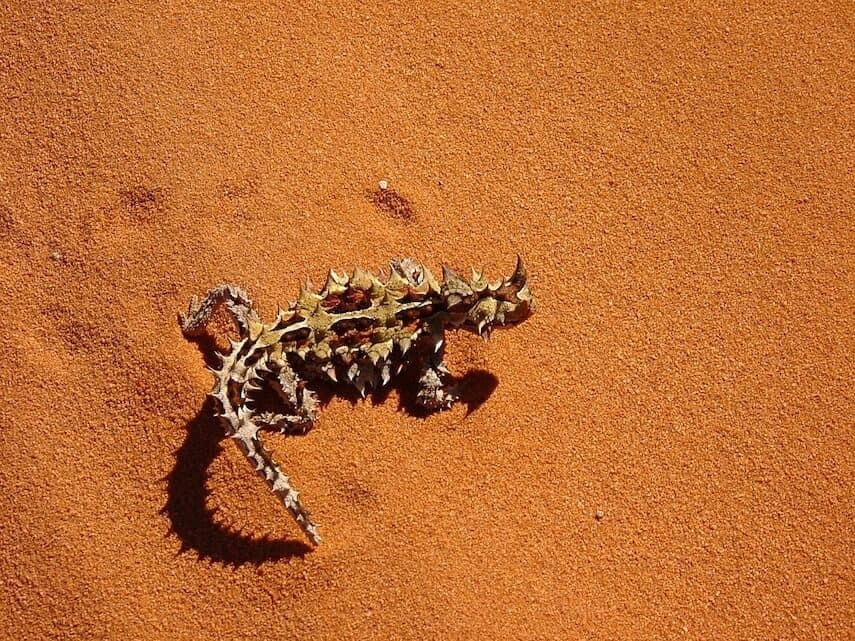
Scientific Name: Moloch horridus
Lifespan: 20 years
Where in Australia are Thorny Devils Found? Thorny devils cover most of arid Australia — large parts of Western Australia, the southern half of the Northern Territory, South Australia, and western Queensland.
Collective Noun: (none)
The Thorny Devil is marred with a wicked common name, and its Latin species name doesn’t sound much better either. They are also called mountain devils, thorny lizards, or molochs. Thorny Devils are day-active, ant-eating reptiles that grow 20cm long with females being slightly larger in size.
Quick Facts about Thorny Devils / Thorny Dragons:
- Thorny devils have a spiny “false head” on the back of their necks.
- They have been recorded to run up to 60km per hour!
- Thorny devils can drink water through their feet.
- They use camouflage as self-defence because their outer body colours perfectly blend with their surrounding habitat.
Cane Toad
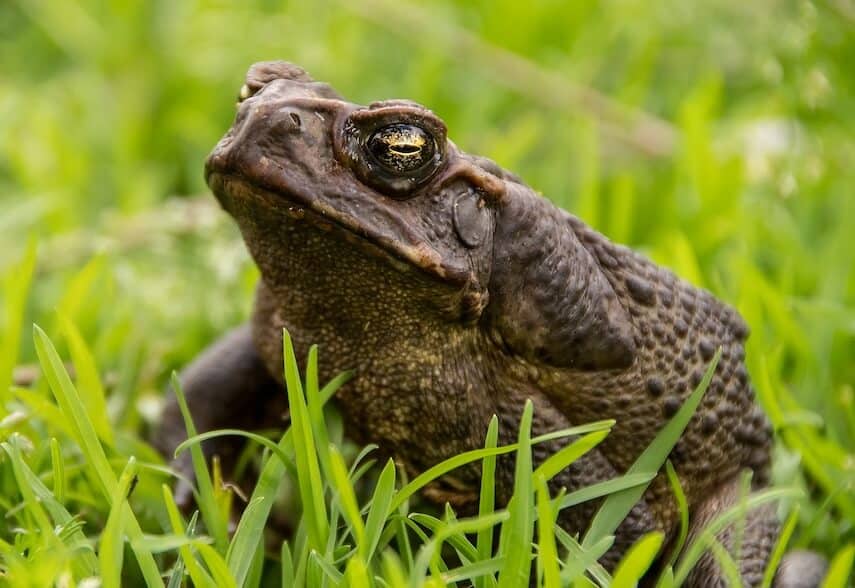
Scientific Name: Rhinella marina
Lifespan: 10-15 years in the wild.
Where in Australia are Cane Toad Found? Cane toads are found in Queensland, the Northern Territory, New South Wales, and Western Australia.
Collective Noun: Giant Knot
The cane toad is also known as the giant neotropical toad or marine toad. It is a large terrestrial toad that was introduced to northern Australia from Hawaii in 1935 in an attempt to control the native cane beetle population – however, quickly became a pest themselves and have continued to spread across Australia. They are also quite a hardy creature and very much capable of poisoning predators that try to eat them!
Quick Facts about Cane Toads:
- Cane toads eat almost about anything.
- Cane toads were introduced to Australia in 1935.
- From 102 cane toads before, they are now around 200 million in numbers!
Sand Goanna
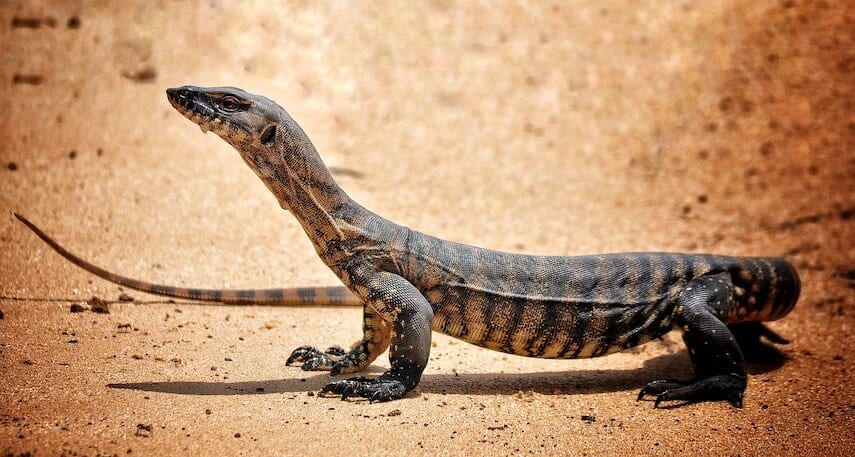
Scientific Name: Varanus gouldii
Lifespan: 40 years
Where in Australia are Sand Goanna Found? Sand Goannas are found throughout most of Australia because they manage to strive in different environments — except in cooler, wetter areas.
Collective Noun: (none)
The sand goanna is a species of large Australian monitor lizard that can reach a length of 140 cm. They excavate large burrows but they can also shelter in rock crevices or tree hollows. Their main diet consists mostly of insects, small lizards, and mice. But, generally, they consider anything smaller than themselves as prey including snakes and other lizards!
Quick Facts about Sand Goannas:
- On average, goannas can reach 4.6 feet in length and 13 pounds in weight.
- Goannas belong to an ancient lineage that evolved in the northern hemisphere during the Cretaceous period — about 90 million years ago!
- Goannas mostly live on the ground and dig holes for nests or burrows to protect their eggs from predators, and also to provide a constant temperature for the embryo’s development.
Dingo

Scientific Name: Canis lupus dingo
Lifespan: Approx 10 years in the wild, up to 15 in captivity
Where in Australia are Dingos Found? Dingoes are found across most of mainland Australia — from deserts to snow-covered alpine areas, from grasslands to rainforests.
Collective Noun: Pack
The Dingo is legendarily known as Australia’s wild dog (although it’s also found in Southeast Asia). Australian dingoes may actually be descendants of Asian dingoes that were introduced to Australia several thousands of years ago.
They are golden or reddish-coloured canids that may live alone or in packs of up to 10 animals. They roam great distances and communicate with wolf-like howls. Dingo hunting is opportunistic. They pursue small game such as rabbits, rodents, birds, and lizards but they also eat fruits and plants. There have been recorded accounts where they also scavenge from humans.
Quick Facts about Dingos:
- Dingoes are just as much wolf as they are dogs, albeit they’re semi-domesticated.
- In the wild, dingoes live somewhere between 5 to 10 years, but they can live longer than 15 years in captivity.
- Dingos do not bark – but howl.
Tasmanian Devil
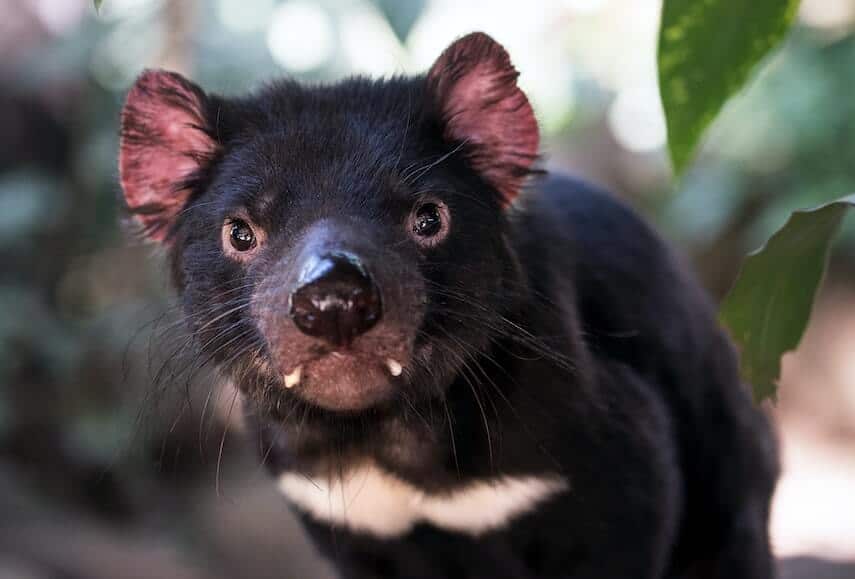
Scientific Name: Sarcophilus harrisii
Lifespan: 5-7 years
Where in Australia are Tasmanian Devils Found? Tasmanian Devils are once abundant throughout Australia. But currently, Tasmanian devils are found only on the island state of Tasmania (as their name implies).
Collective Noun: (none)
These famously feisty mammals have a coat of coarse brown or black fur and a stocky profile that gives them the appearance of a baby bear. Most have a white stripe or patch on their chest and light spots on their sides or rear end. They have long front legs and shorter rear legs.
It is the world’s largest carnivorous marsupial with a length of 30 inches and weight of up to 26 pounds. Its size usually varies widely depending on where it lives and the food it consumes. Its oversize head has sharp teeth and strong, muscular jaws that can deliver one of the most powerful bites of any mammal!
Quick Facts about Tasmanian Devils:
- Tasmanian devils can eat up to 40% of their body weight in a day!
- A plump tail is a sign of a healthy Tassie devil.
- The mother Tassie devil gives birth to around 20-40 Joeys at once. But because she only has 4 teats, her joeys have to race to her pouch.
- They are also incredible swimmers and can run at 24 km/h for up to an hour without rest.
Bushy Tailed & Ring Tailed Possum
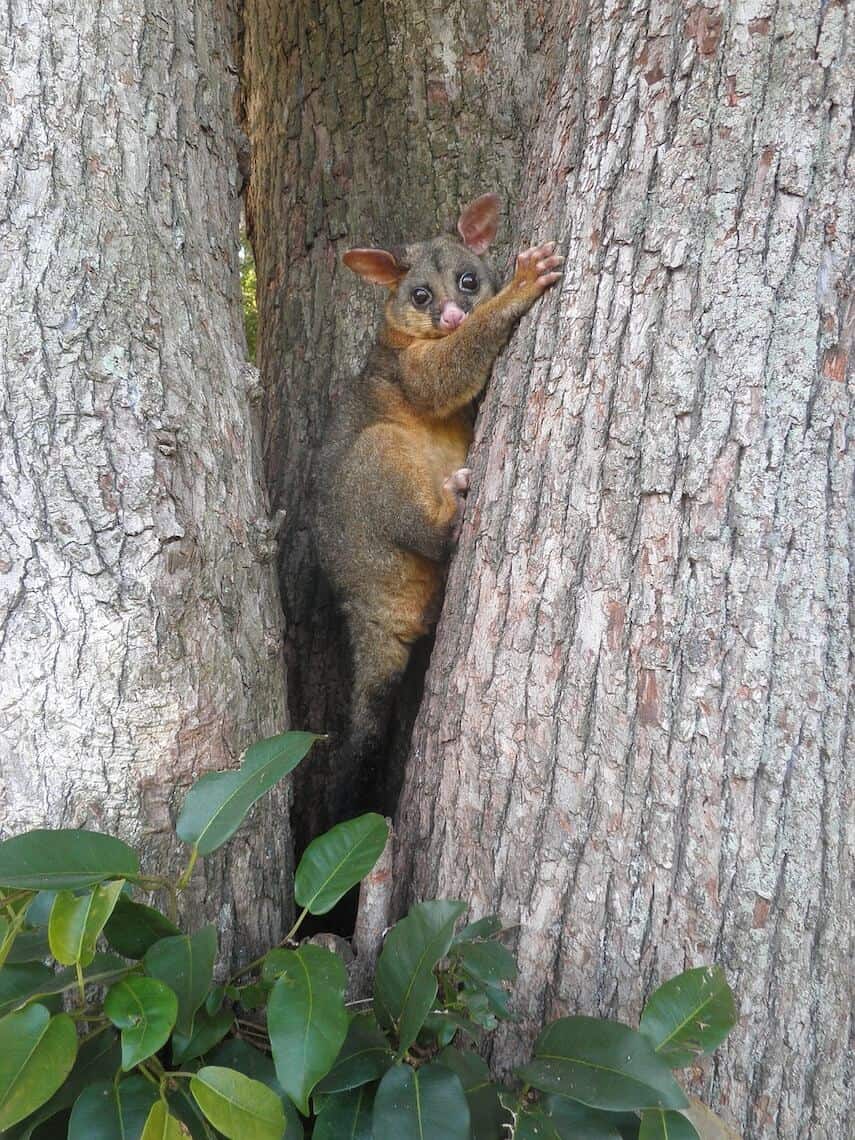
Scientific Name: Phalangeriformes
Lifespan: 6-7 years
Where in Australia are Bushy Tailed & Ringtailed Possums Found? The brush-tailed and ring-tailed possum are widely distributed in Australia. They can be found in forests and woodlands all along the east coast, and also live in inland areas along tree-lined rivers and creeks.
Collective Noun: (none)
The bushy-tailed possums are agile climbers and are more often heard than seen (most especially during the mating season). They have silvery fur, large ears, and dark bushy tails.
Ring-tailed possums, on the other hand, are easily identifiable with their white-tipped prehensile (gripping) tail, and the two thumbs on each of their front feet which helps them to grasp branches when climbing.
Quick Facts about Bushy Tailed Possums:
- Bushy-tailed & Ring-tailed Possums are mainly herbivores who feed upon leaves, shoots and flowers, supplementing its diet with clovers, grasses, garden fruits and turnips.
- They exhibit promiscuous mating systems — both males and females have multiple mates.
- They use secretions from the glands found near their chin, chest, and tail to mark their home territories.
- They generally change in colour and size depending on where they live.
Quoll
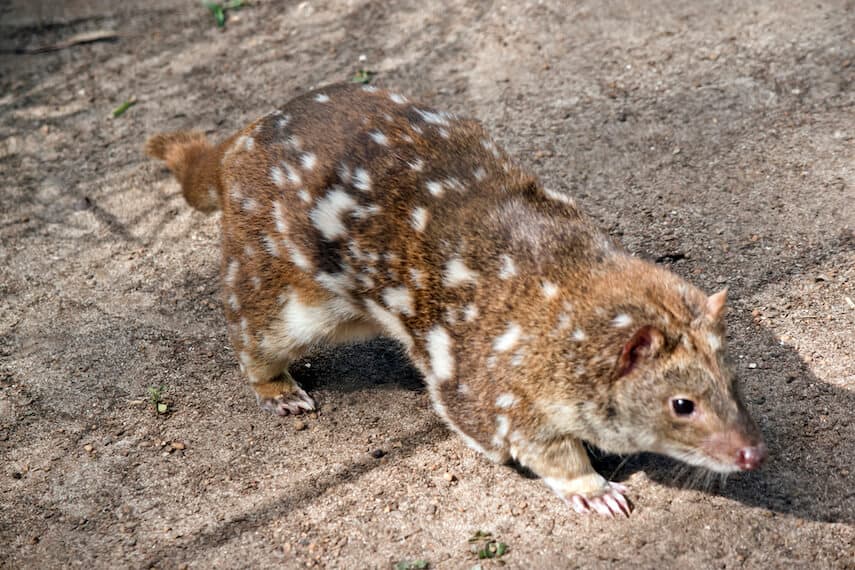
Scientific Name: Dasyurus
Lifespan: 2-5 years (dependant on size)
Where in Australia are Quoll Found? The eastern quoll was once found across much of the southeast mainland of Australia — from the eastern coasts of South Australia through most of Victoria, to the north coast of New South Wales.
Collective Noun: (none – they are solitary creatures)
Quolls are tree-climbing, den-dwelling marsupials that were relatively abundant across most of Australia before European settlement. Four species of quoll occur in Australia: the northern, spotted-tailed, eastern, and western quolls. They are the largest native carnivorous marsupial on Earth.
Quick Facts about Quolls:
- In total, 6 species of quolls differ in size, the colour of the fur, and type of habitat.
- Quolls inhabit forests, shrublands, and grasslands at the altitude of up to 11,400 feet!
- They can reach up to 29.5 inches in length and up to 15.4 pounds in weight.
Christmas Island Red Crab
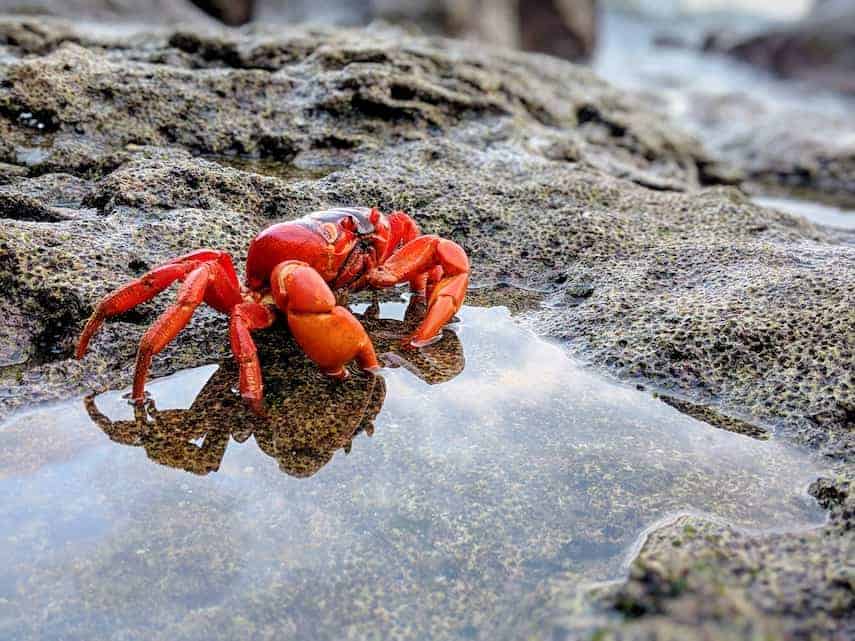
Scientific Name: Gecarcoidea natalis
Lifespan: 20-30 years
Where in Australia are Christmas Island Red Crabs Found? Christmas Island red crabs are found within Christmas Islands’ forests (although they migrate to the coast to breed).
Collective Noun: Cast, consortium
Christmas Island red crabs are large crabs with their carapace measuring up to 116 millimetres wide. The male crabs are generally larger than the females, while adult females have a much broader abdomen (only apparent above 3 years of age) and usually have smaller claws.
Quick Facts about Christmas Island Red Crabs:
- Christmas Island red crabs live in the forest for most of the year hiding under branches or leaves on the forest floor or inside rocky outcrops.
- They reach sexual maturity around 4 and 5 years of age.
- After mating (usually occurs in October or November), the males return to the forest while the females remain for another two weeks because they release their eggs into the water.
Robber Crab / Coconut Crab

Scientific Name: Birgus latro
Lifespan: 60 years
Where in Australia are Coconut Crabs Found? Christmas Island & Cocos Keeling Islands
Collective Noun: Cast, Consortium
Coconut crabs forage on the forest floor — feeding mainly on fruits, seeds, and the pith of fallen trees (especially the Arenga palm). They also scavenge at the carcasses of dead animals (including other crabs) and may prey on turtle hatchlings. Robber crabs are exceptional climbers and can often be seen slowly making their way up tree trunks or along with rock faces.
Quick Facts about Coconut Crabs:
- The coconut crab is the world’s biggest land crustacean. It can weigh more than 4 kg and can measure up to a metre across!
- Christmas Island has the world’s largest and best-protected population of these gentle giants.
- The robber crab is named because of its habit of carrying off any foreign items it comes across —particularly shiny objects like pots and silverware.
Australian Coastal Taipan
Scientific Name: Oxyuranus scutellatus scutellatus
Lifespan: 10-15 Years
Where in Australia are Coastal Taipans Found? The Coastal Taipan lives in the far west and southwest of Queensland, extending through the far west of New South Wales into the northeast corner of South Australia, and into the southeast of the Northern Territory.
Collective Noun: Den, Nest, Knot, Pit, Bed
The coastal taipan is the longest highly venomous snake in Australia. The coastal taipan uses abandoned animal burrows, hollow logs, and piles of vegetation and litter as shelters. The adults typically attain sexual maturity when they reach around 4 feet in total length (including their tails).
Quick Facts about Coastal Taipans:
- The coastal taipan is also known as the common or eastern taipan.
- It has mainly diurnal habits but in hot weather conditions, it may become nocturnal.
- The coastal taipan will seek to escape any threat. If cornered and very much threatened, though, it can become very aggressive and may strike repeatedly.
Huntsman Spider
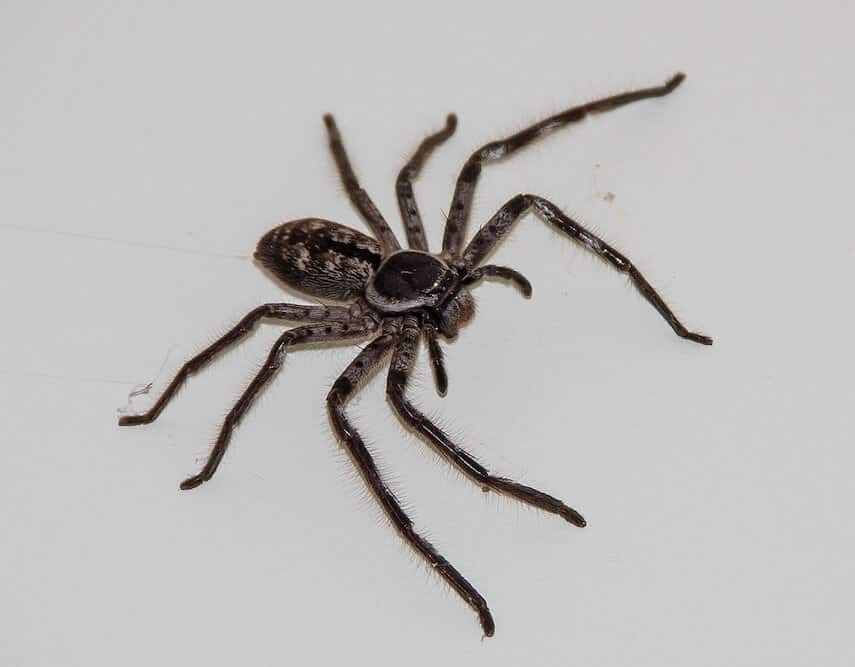
Scientific Name: Sparassidae
Lifespan: Approx 2 years.
Where in Australia are Hunstman Spiders Found? Huntsman Spiders are everywhere in Australia particularly found living under loose bark on trees, in crevices on rock walls and logs, under rocks and slabs of bark on the ground, and on foliage.
Collective Noun: Cluster, Clutter.
Huntsman Spiders are large, long-legged spiders, measuring up to 15 centimetres across their legs. Huntsman Spiders are mostly grey to brown, sometimes with banded legs. Their diet consists of insects and other invertebrates. Male huntsman spiders make a sound when females are nearby — and these spiders have a lengthy courtship.
Quick Facts about Huntsman Spiders:
- The Huntsman Spider has 8 eyes!
- Many huntsman spiders live peacefully together in large colonies.
- Huntsman spiders also moult to grow. Their old skin may be mistaken for the original spider when seen suspended on bark or in the house.
- Adult Huntsman spiders do not build webs, however, they hunt and forage for food.
- They are not venomous – however, have been responsible for causing several car accidents, as drivers tend to panic if they suddenly see one in the car while they are driving!
Click to read more Fascinating Facts About Australia
Native Australian Birds
Emu
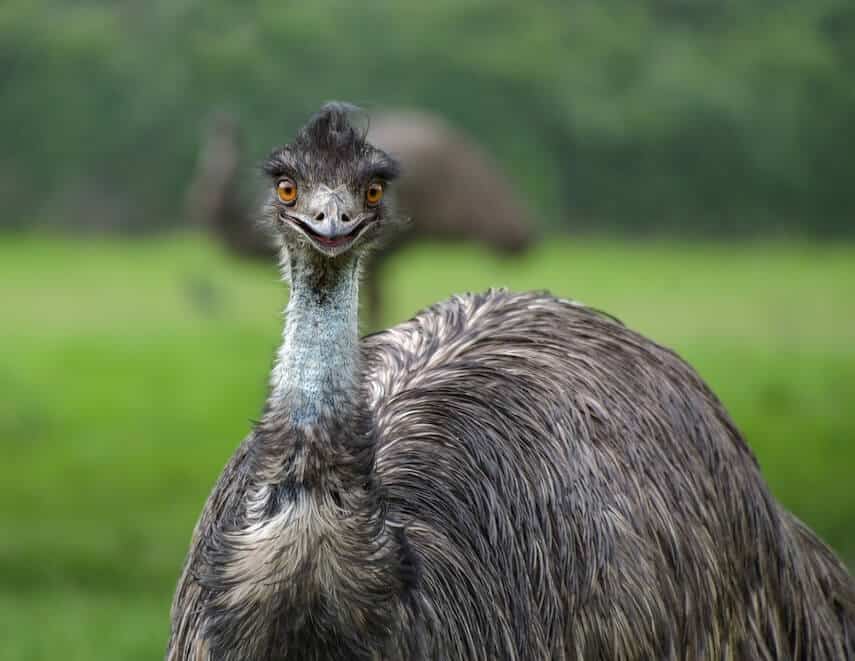
Scientific Name: Dromaius novaehollandiae
Lifespan: 5-10 years
Where in Australia are Emus Found? The Emu is found only in Australia. It lives throughout most of the continent ranging from coastal regions to high in the Snowy Mountains.
Collective Noun: Mob
Emus are flightless birds of Australia. They are actually the second-largest living bird on Earth. The emu is more than 5 feet tall and may weigh more than 45 kg (100 pounds). Adult Emus are covered with shaggy grey-brown feathers except for the neck and head, which are largely naked and bluish-black. The wings are greatly reduced, but the legs are long and powerful. Each foot has three forward-facing toes and no hind toe.
Quick Facts about Emus:
- Emus have two sets of eyelids specifically for blinking and for keeping the dust.
- The male and female remain together for 5 months during nesting season which includes courtship, nest building, and egg-laying.
- Young emus stay with their fathers instead of their mothers.
Kookaburra

Kookaburras are found throughout eastern Australia. They have been introduced to Tasmania, the extreme south-west of Western Australia. In favourable conditions, they can live for 20 years or so, and have the same partner for life. Kookaburras are generally a rather stout bird, with a medium-length tail, and a broad beak.
Cassowary

The Cassowary is one of Australia’s most imposing birds — a flightless bird with glossy black plumage, a tall, brown casque (helmet) on top of its head, a vivid blue and purple neck, long drooping red wattles, and amber eyes that are believed to survive for up to 40 years. They are found only in the dense tropical rainforests of north-east Queensland.
Cockatoos
Sulfur Crested Cockatoo
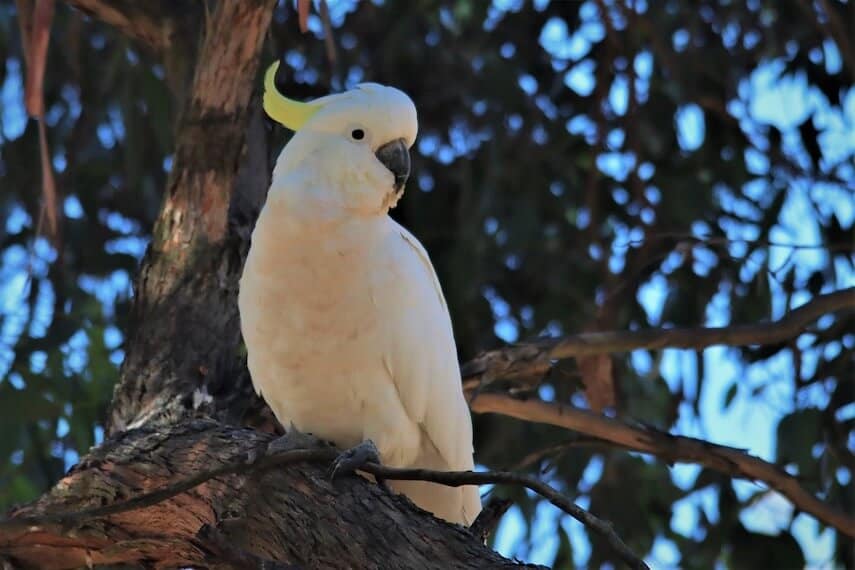
The Sulphur-crested Cockatoos’ range extends throughout the northern and eastern mainland, and Tasmania. A small population has also been established around Perth, Western Australia. The Sulfur-crested Cockatoo can live for about 20-40 years in the wild. Their very distinctive feature is the long, recurved crest of bright yellow feathers.
Red-Tailed Cockatoo

You will usually hear them calling to each other with a high-pitched guttural before you see them. They love to flock and settle noisily high in their favourite food tree. Red-tailed cockatoos are found in a range of environments, but are found mostly in Eucalyptus forests or woodlands, and often in adjacent areas of woodlands or shrublands. They can live for about 45-50 years in captivity.
Galah Cockatoo
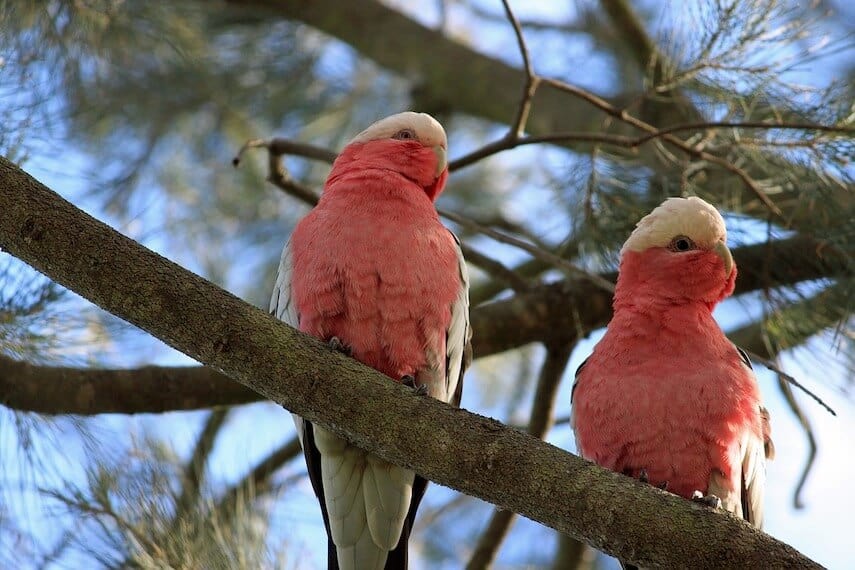
The Galah is one of the smaller species of cockatoo. Its chest is bright pink, its wings are light grey, and its crest is whitish pink. Known as the pink and grey cockatoo or rose-breasted cockatoo, it is easily one of the most common and widespread cockatoos. It can also be found in almost all parts of mainland Australia. A Galah will rarely live past 25 years in the wild. Although in captivity, a Galah can live for 40 years or more.
Pelican
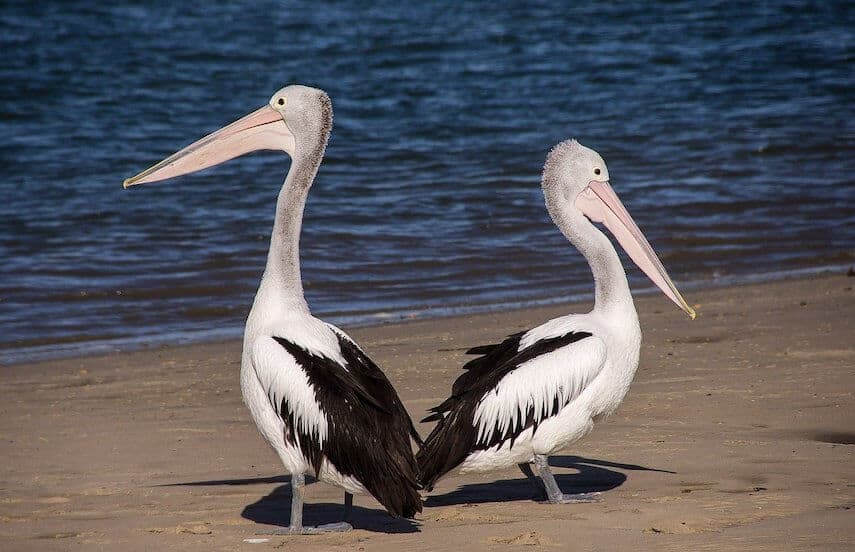
Pelicans are undoubtedly most famous for their characteristic pouch. These large aquatic birds are predominantly light coloured (except two brown species). Pelicans can live for about 15-25 years in the wild. Australian pelicans are one of the world’s heaviest flying birds and boast the longest bills (up to 40 cm) of any known bird!
Rainbow Lorikeet

The rainbow lorikeet is a small, brightly coloured parrot. Male, female, and immature birds all look similar to young birds slightly duller in colour. They have a bright yellow-orange/redbreast, a mostly violet-blue throat, and a yellow-green collar. Rainbow Lorikeets are widespread in eastern and northern Australia, and also around Perth. They can live for about 7-9 years in the wild.
Bush Turkey / Scrub Turkey
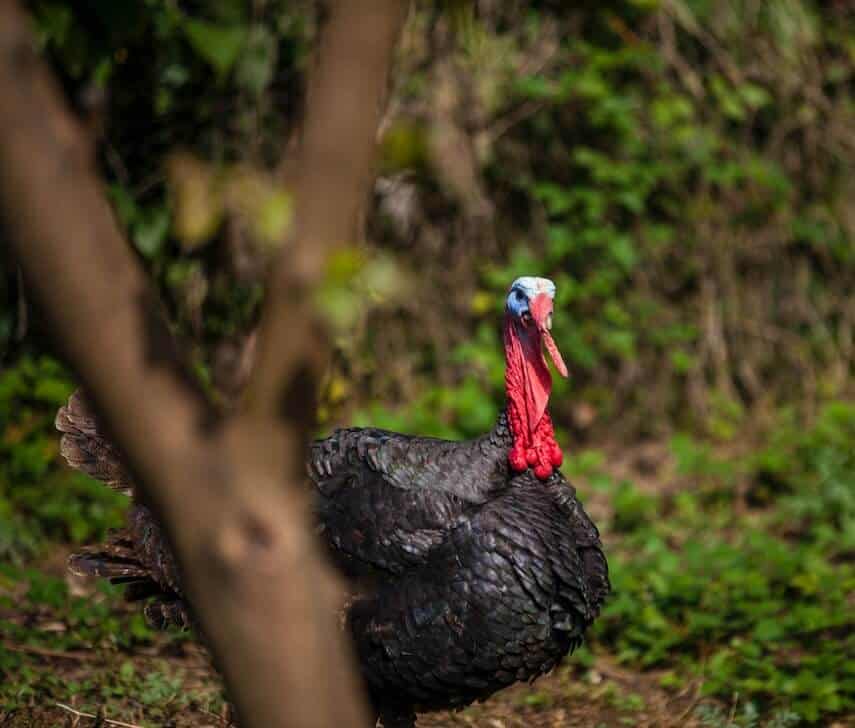
The brush-turkey grows up to 60–75 cm long and has a wingspan of 85 cm. Males and females are similar in size. The brush-turkey (blue-black in colour) has an upright fanlike tail and grey-edged breast feathers. It has strong legs and a featherless deep red head and neck. Their range extends along with eastern Australia, from the Cape York Peninsula, Queensland, south to the northern suburbs of Sydney, and the Illawarra region of New South Wales.
Crimson Rosella
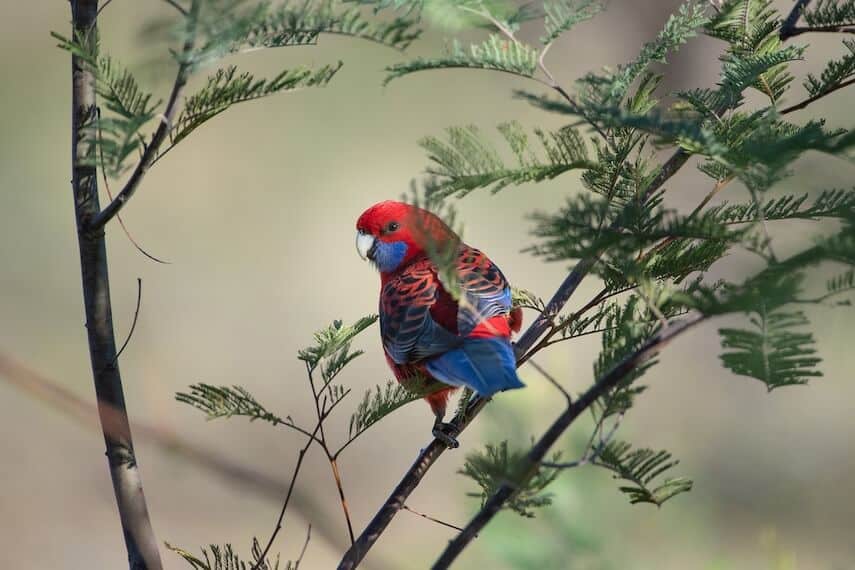
The Crimson Rosella is a parrot native to eastern and southeastern Australia commonly found in mountain forests and gardens. They are relatively easy to see because they forage on the ground or among the leaves of eucalyptus with their spectacular combination of deep-crimson, royal-blue, and black plumage. Crimson Rosellas are also believed to live for about 25 years.
Australia’s Famous Sea-Life
While a lot of these animals are technically not ‘native’ to Australia, they are frequent visitors and are either loved or feared as honorary Aussies!
Great White Shark

Scientific Name: Carcharodon carcharias
Lifespan: 70 years
Where in Australia are Great White Sharks Found? Great Whites have been recorded from Moreton Bay in Queensland, around the south coast of Australia, and over to West Cape in Western Australia.
Collective Noun: A Shiver of Sharks
Found in cool, coastal waters around the world, great whites are the largest predatory fish (fish that eat other fish or animals) on Earth. They grow to an average of 15 feet in length, though specimens exceeding 20 feet and weighing up to 5,000 pounds have been recorded.
Quick Facts about Great White Sharks:
- Great white sharks can be found throughout the world’s oceans, mostly in cool waters close to the coast.
- They grow to around 4.6m long on average but some great whites have been measured at 6m — which, approximately, is half the length of a bus!
- Great white sharks are grey with a white underbelly, from where they get their name.
- They have powerful tails, along with their streamlined shape, that allows them to propel through the water at over 60km per hour!
- Great white sharks are just one of 170 species of sharks that swim in Australian waters.
Whale Shark

Scientific Name: Rhincodon typus
Lifespan: up to 100 years
Where in Australia are Whale Sharks Found? Whale sharks are widely distributed in Australian waters. Although most common at Ningaloo Marine Park (along with Christmas Island and in the Coral Sea), sightings have been confirmed further south than Kalbarri (on the mid-west coast of Western Australia), and Eden (on the New South Wales south coast).
Collective Noun: Shiver
The whale shark is the world’s largest fish measuring up to 15 meters in height and 18 metric tons in weight. Its head is broad and flattened with a large terminal mouth, minuscule teeth, and large gill slits. Their eyes are small and located just behind the mouth on each side of the head.
Quick Facts about Whale Sharks:
- Whale sharks are slow swimmers and migrate a long way.
- Despite their size, whale sharks are often referred to as “gentle giants”.
- Whale sharks are filter feeders and can neither bite nor chew.
- Although its mouth can stretch up to 4 feet wide, a whale shark’s teeth are so tiny that they can only eat small shrimp, fish, and plankton by using their gill rakers as a suction filter.
Little Penguin
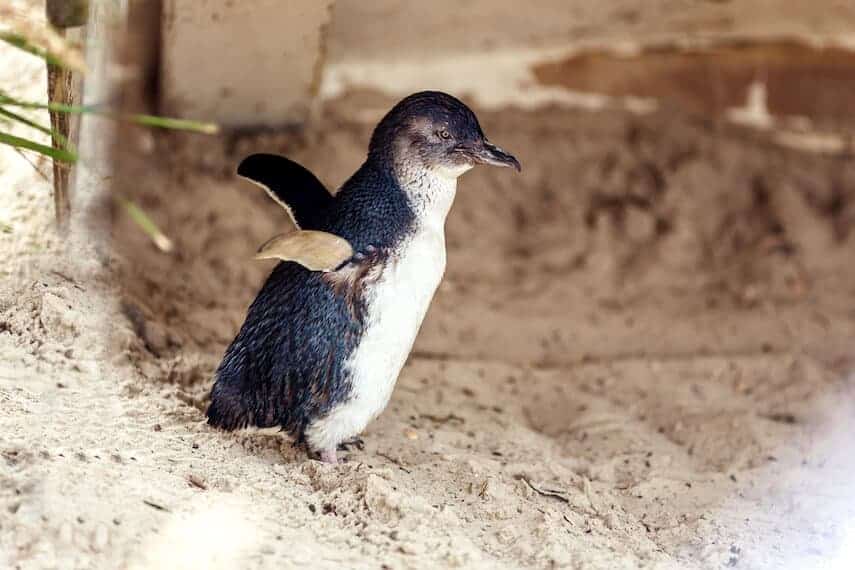
Scientific Name: Eudyptula minor
Lifespan: Average of 6-7 years
Where in Australia are Little Penguins Found? Along the Southern Coast of Australia (notably at Victoria’s Phillip Island)
Collective Noun: In the water – a raft, on land – a waddle.
Once known as Fairy Penguins (before the name was considered offensive), the Little penguin is the smallest of all 17 penguin species. They rely on burrows and a nocturnal lifestyle to avoid predators such as gulls, snakes, rats, and lizards.
Quick Facts about Little Penguins:
- They are only around 33cm tall and weigh about 1kg
- Phillip Island is home to over 32,000 Little Penguins – to the largest colony of little penguins in the world.
- The maximum swimming speed for little penguins is about 6 kph (3.7 mph).
Dugong
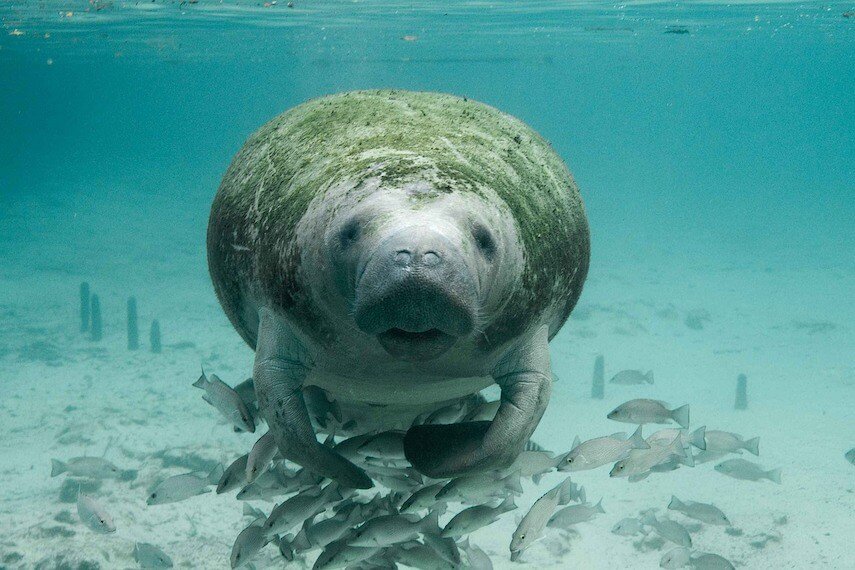
Scientific Name: Dugong dugon
Lifespan: 70 years
Where in Australia are Manatees Found? Dugongs occur in the shallow coastal waters of northern Australia from the Queensland/New South Wales border in the east to Shark Bay on the Western Australian coast.
Collective Noun: Herd
Dugongs are related to manatees and are similar in appearance and behaviour — though the dugong’s tail is fluked like a whale’s. Dugongs graze on underwater grasses day and night, rooting for them with their bristled, sensitive snouts and chomping them with their rough lips. They can stay underwater for 6 minutes before resurfacing. They sometimes breathe by “standing” on their tail with their heads above water.
Quick Facts about Dugong:
- The world’s largest population of Dugong resides in northern Australia.
- They’re the only marine mammal that has a diet consisting solely of seagrass.
- The closest land relative to the dugong is the elephant.
- Female dugongs only have one calf after a year-long pregnancy.
Australian Cape Fur Seal

Scientific Name: Arctocephalus pusillus
Lifespan: 12-30 years
Where in Australia are Cape Fur Seals Found? Australian fur seals are found along the coast and continental shelf and slope waters from Victoria, along with southern New South Wales, including Tasmania, and the islands of Bass Strait.
Collective Noun: Colony
The Cape Fur Seal has a wide head that is relatively large with small, external ear flaps, and a pointed snout. The mane of the male is darker while the belly is quite light. Females do not have a mane and are, generally, lighter in colour, although their back and belly are darker. Once they have reached adulthood, males are normally much larger than females — weighing up to 350 kg. Females typically weigh in at around 80 kg but can grow up to 150 kg.
Quick Facts about Cape Fur Seals:
- Females can delay fertilisation for up to 3 months, to ensure that they will only give birth to pups at the beginning of summer.
- Cape fur seals feed on shoaling fish, squid, octopus, sharks, and rays.
- They can dive to depths of over 200 metres and hold their breath for up to 8 minutes!
- They generally hunt alone but can form hunting parties of up to 15 individuals.
Australian Sea Lions
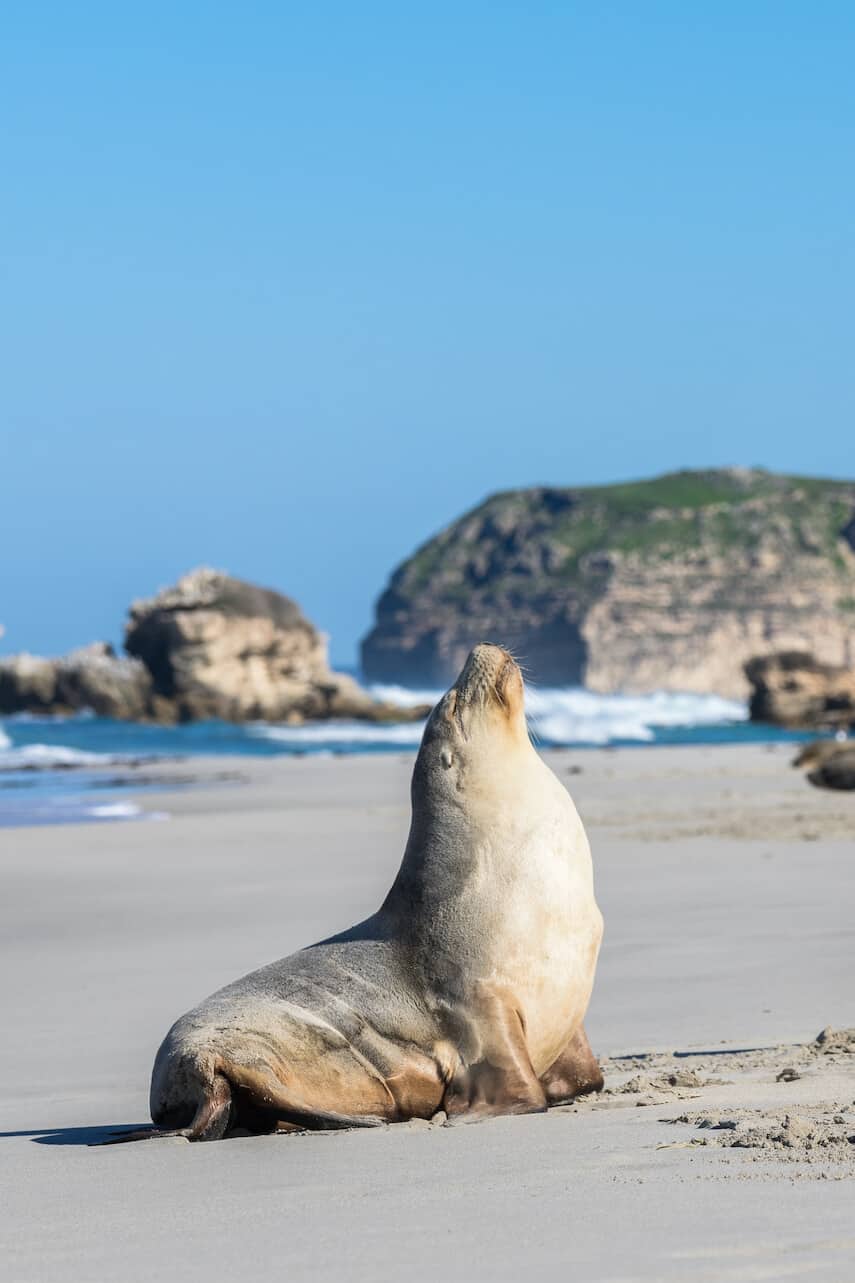
Scientific Name: Neophoca cinerea
Lifespan: 25 years
Where in Australia are Sea Lions Found? Australian sea lions are a type of seal that is native only on Australian shores. These beautiful animals live in colonies made up of small populations along the coastline of South Australia (SA) and Western Australia (WA).
Collective Noun: Colony
The Australian sea lion is “sexually dimorphic” which means that there are significant physical differences between males (bulls) and females (cows). Australian sea lions swim using their long, powerful fore flippers and hind flippers. They swim using their long fore flippers to generate power and their hind flippers to steer. They hunt underwater and can dive to depths of 300 metres!
Quick Facts about Sea Lions:
- The Australian Sea Lion is one of the rarest species on the planet.
- Australian sea lions are strong swimmers and can reach speeds of nearly 20 miles per hour in the water.
- Their gestation period is a whopping 17-18 months! After giving birth, females will typically mate again within seven to 10 days.
Southern Right Whales
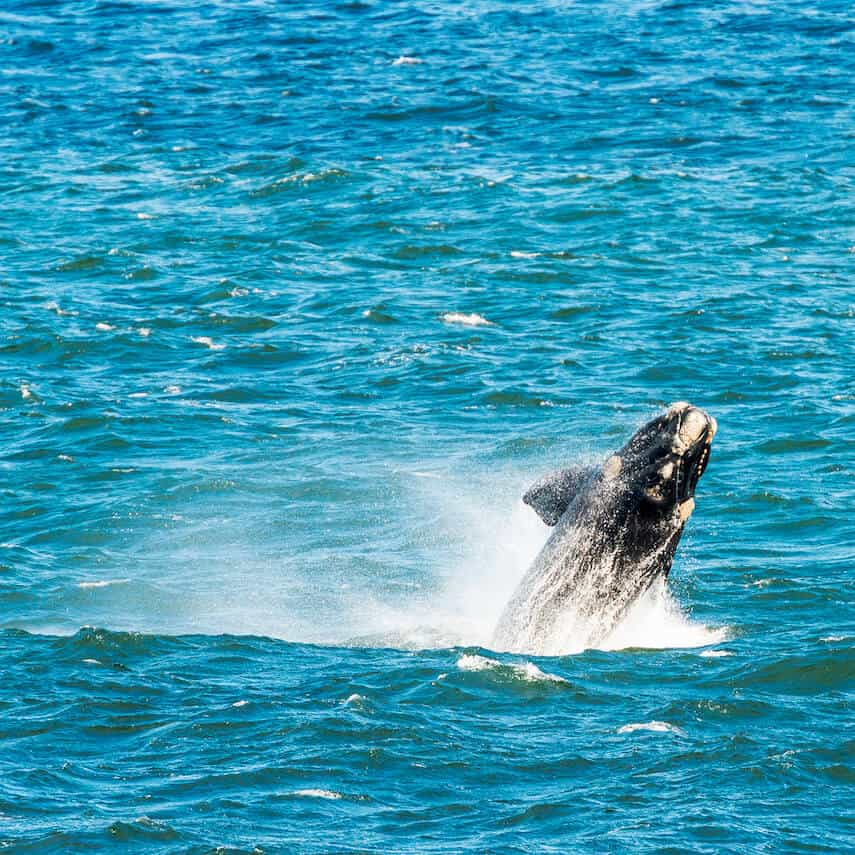
Scientific Name: Eubalaena australis
Lifespan: 50 years
Where in Australia are Southern Right Whales Found? Southern Right Whales have an annual migration between summer feeding grounds in the sub-antarctic waters of the Southern Ocean to more temperate waters off the coast of southern Western Australia, South Australia, Tasmania, Victoria, and occasionally in New South Wales.
Collective Noun: Pod
The Southern Right Whale has an average length of 16 metres (weighing about 50 tonnes)! They have a distinctive, bulky blue-black or dark brown rotund body which features obvious white markings (callosities) around their mouths, above the eyes, and on top of their heads. The pattern of these skin growths is unique to each animal and is used for their individual photo identification.
Quick Facts about Southern Right Whales:
- The Southern Right Whale can be found in subtropical waters of the southern hemisphere.
- Their calluses are elevated areas of skin (more than 5cm thick) on different parts of their heads.
- Southern Right Whales are generally calm, curious, and quite slow to swim.
- To communicate with one another, they jump and splash their fins in the water.
Australian Humpback Whales
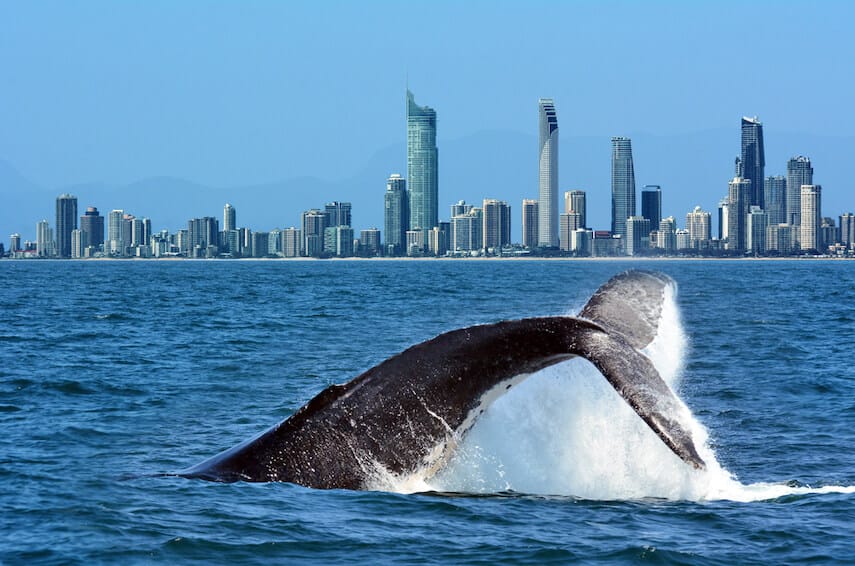
Scientific Name: Megaptera novaeangliae
Lifespan: 45-50 years
Where in Australia are Humpback Whales Found? The Humpback Whale is a large baleen whale that migrates annually along the east and west coasts of Australia.
Collective Noun: Pod
The Humpback Whale has distinctive knobbly protuberances on the head and long flippers. These characteristics easily make them recognisable. Its name is derived from the hump under their dorsal fins which are particularly noticeable when they arch their backs to dive.
Quick Facts about Humpback Whales:
- Like a human fingerprint, the tail of each humpback whale is unique.
- Humpbacks have about 270-400 darkly coloured baleen plates on each side of their mouths.
- Newborn humpback calves are about the length of their mother’s head and weigh about 2 tons (most cars weigh about 1/2 ton).
Bottlenose Dolphins
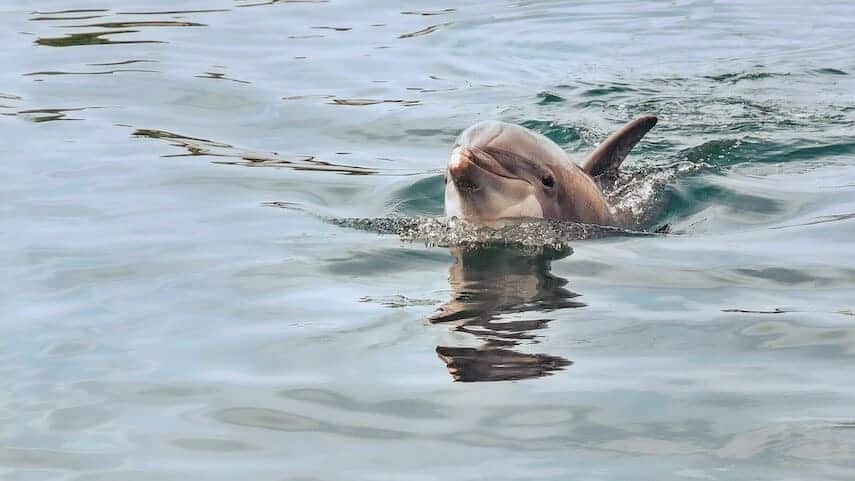
Scientific Name: Tursiops aduncus
Lifespan: 40 years
Where in Australia are Bottlenose Dolphins Found? The bottlenose dolphin can be found right around the coast of Australia, specifically in temperate and tropical waters. They occupy a diverse range of habitats including open coasts, sheltered bays and waterways, lagoons, large estuaries, and the lower reaches of rivers.
Collective Noun: Pod, School
The Bottlenose Dolphin has a short rounded snout, described as bottle-shaped, a smooth rounded melon. The large dorsal fin is slightly hooked and set halfway along the body. Their overall body colour is a series of grey tones with an indistinct paler grey wash on the flanks fading into an off-white belly.
They have access to a huge variety of organisms including invertebrates, bottom-dwelling fish and squid, plus the full range of pelagic (oceanic) fish species. They are very social and are also known to take advantage of human-induced prey abundance by approaching fishing trawlers.
Quick Facts about Bottlenose Dolphins:
- Common bottlenose dolphins swim just under 12 miles per hour (19 kph).
- Female bottlenose dolphins give birth to a calf every 3 to 6 years after a 12-month gestation period.
- They usually travel alone or in groups of about 12 but herds of hundreds of dolphins have been spotted.
Australian Box Jellyfish
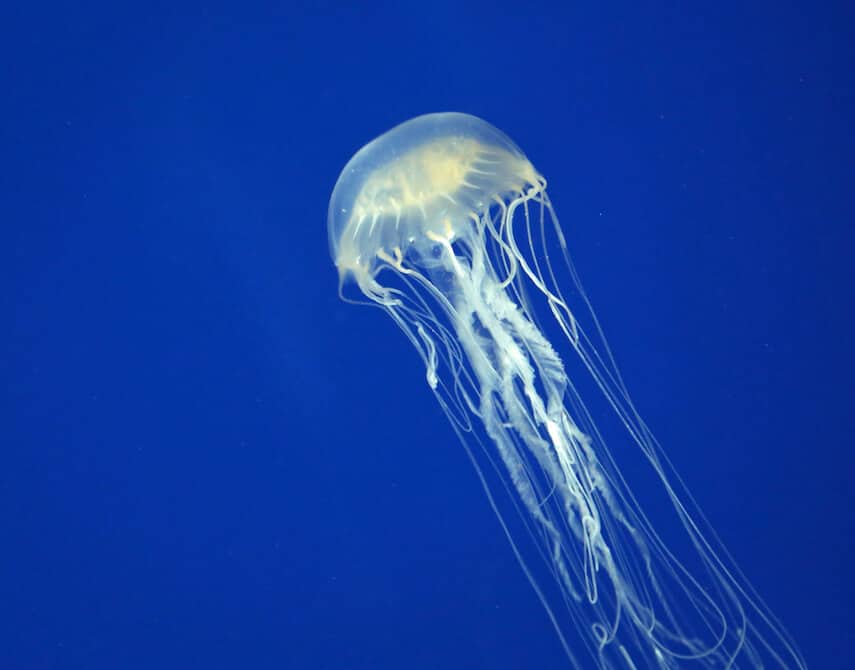
Scientific Name: Chironex fleckeri
Lifespan: No more than 12 months.
Where in Australia are Box Jellyfish Found? Box jellies (also called sea wasps and marine stingers) live primarily in coastal waters off Northern Australia.
Collective Noun: Bloom, Swarm or Smack
Australian Box Jellyfish are pale blue and transparent in colour. They got their name from the cube-like shape of their bell. Up to 15 tentacles can grow from each corner of their bell and can reach 10 feet in length. The venom that Australian Box Jellyfish carries contains toxins that attack the heart, nervous system, and skin cells because each tentacle has about 5,000 stinging cells!
Quick Facts about Box Jellyfish:
- Australian Box Jellyfish is considered the most venomous marine animal on Earth.
- The lethal varieties of box jellyfish are found primarily in the Indo-Pacific region and northern Australia.
- They can swim up to 6 metres per minute!
- Box Jellyfish will shrink if they don’t eat.
And that’s a wrap. We hope you enjoyed our guide to some of Australia’s incredible native animals. Which one is your favourite? How many have you seen in the wild? And are there any others that you think we should have included? Let us know in the comments below!
And if you don’t mind sharing the love for this Native Australian Animals Guide, a tweet, flip, pin, or Facebook share would be much appreciated! (Full-sized pins available by clicking the share bar on the left – and all the images above are pins too!)

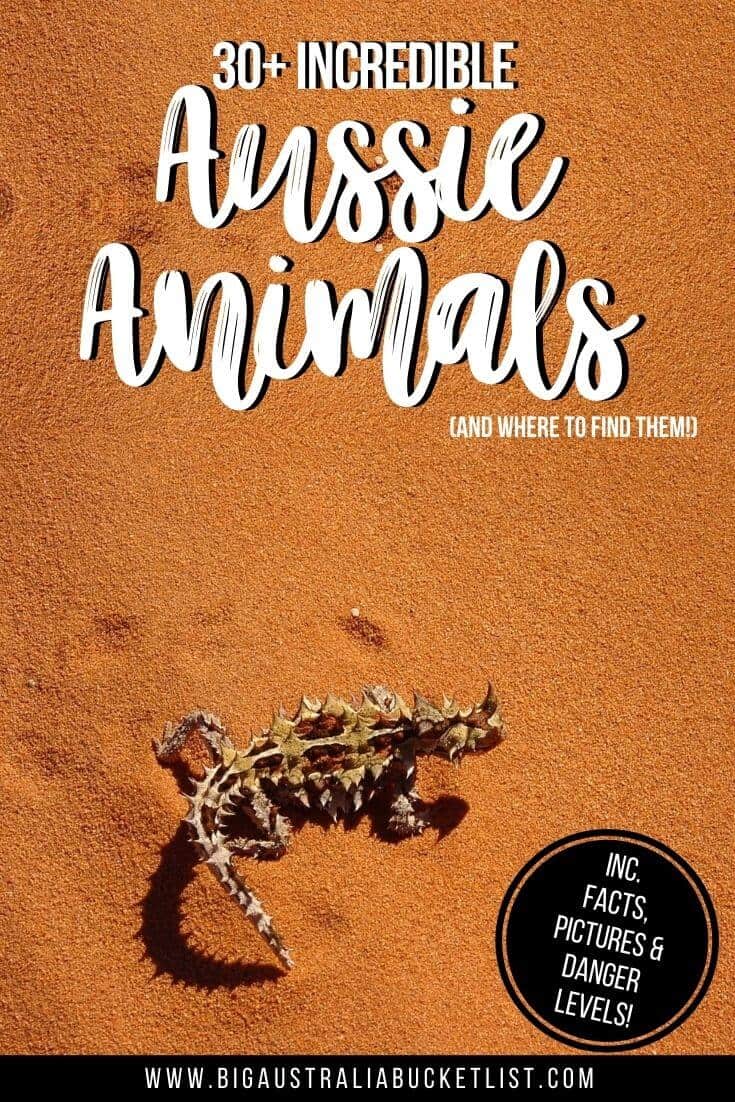
READY MORE TRAVEL INSPIRATION? YOU MIGHT BE INTERESTED IN THESE RECENT POSTS, TRAVEL ARTICLES, DESTINATION GUIDES, TRAVELER RESOURCES, TRAVEL GEAR GUIDES AND RELATED POSTS ABOUT OTHER AMAZING PLACES AROUND AUSTRALIA:
- Test Your Aussie Knowledge: The Big Australia Trivia Quiz + 80+ Interesting Facts about Australia
- New South Wales: Top Things to do in Sydney (inc. The Sydney Opera House, Byron Bay & the Blue Mountains) & Best Places to visit in NSW + Incredible Ski Resorts in NSW
- South Australia: Guide to the Ikara Flinders Ranges
- Northern Territory: Best Things to do in Darwin
- Victoria: Free Things to do in Melbourne, Melbourne Travel Guide (Perfect for First Timers), Best Time To Visit Melbourne (Month by Month Guide) + Best Day Trips from Melbourne (inc. the Great Ocean Road)
- General Australia Inspiration: 25 Best Places to Visit in Australia + Best Australian Travel Apps + Australia Travel Tips to Know Before You Go + 35+ Australian Foods You HAVE To Try
- Queensland News & Events: Things to do on the Gold Coast, Great Barrier Reef & 50 Things to do in Outback Queensland

Hi There! Thanks for reading our post about 30+ Incredible Australian Animals (+ Where to Find Them)! I just wanted to let you know that this post contains affiliate links, which means if you purchase something after clicking a link, I may get a small commission – which is at absolutely no cost to you. If you enjoyed this article and are going to be searching for some of the things I mention anyway, I would love it if you could click through from the links above & thank you in advance! Read my full disclosure here.
